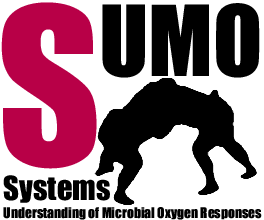SysMO - SUMO - Systems Understanding of Microbial Oxygen Responses
About this wiki
The SUMO wiki is the central communication platform for the exchange of information about experimental data, models, ideas and general issues. This subpage is the starting point for publicly available information about the project.
About SUMO
General Information
The bacterium Escherichia coli is a common inhabitant of the human gut but is also of special interest as a laboratory experimental tool; many decades of study have produced an impressive description of processes essential for life. However we must now consider how the individual components that make up a biological system work together to produce coherent patterns of behaviour. We have chosen to investigate the responses of E. coli to varying conditions (e.g. oxygen availability, alternative electron acceptors and different carbon sources), because:
- The system is composed of relatively simple modules that participate in complex interactions;
- There is a detailed parts list of the main regulatory systems (genome sequence, participating proteins, molecular mechanisms);
- There are existing published data sets and data from precursor projects that permit the integration of specific and sound mathematical modelling approaches from the very beginning of the project; and
- Powerful techniques for highly controlled and reproducible experiments are available (transcriptomics, facile genetics, chemostat culture);
- The system is biologically, medically and industrially significant.
SysMO - SUMO1 - Systems Understanding of Microbial Oxygen Responses
This project first started out in 2007 named SUMO (Systems understanding of Microbial oxygen responses) and was founded by the European research initiative SysMO (SysMo). During the first 3years of founding we used a multiple systems level approach to broaden our knowledge about the metabolic adaption that occurs in response to changes in oxygen availability. Especially the application of commonly agreed protocols which led to highly reproducible transcriptomic, proteomic, metabolomic and biochemical data sets helped to describe the dynamics of E.colis response to oxygen. Specifically, we investigated how this bacterium senses oxygen or the associated changes in oxidation/reduction balance, via the Fnr and ArcA proteins, how these systems interact with other regulatory systems, and how the redox response of an E. coli population is generated from the responses of single cells. Furthermore these data sets of high quality have been implemented into mathematical models and computer science models of various types (e.g. ODE- and Agent-based modeling). This allowed us to set up new model-based hypothesis and additionally on this basis new experiments have been designed to help validate our models and extend our knowledge about metabolism.
SysMO - SUMO2 - Systems Understanding of Microbial Oxygen-Dependent and Independent Catabolism
In 2011 we kindly received another funding from the SysMO-initiative. Here in SUMO2 our aim is to extend our SUMO1 project work to obtain a complete, quantitative description of the integrated catabolic subsystems of E. coli, from regulation to energy conservation. To achieve this goal, SUMO2 will build upon the progress made in SUMO by extending our systematic analysis of E. coli catabolism into three new thematic areas:
- System dynamics during transition to anaerobic respiration and in response to pulses of electron acceptors
- Adaptive responses to different catabolic modes
- Multi-scale and multi-level modelling of catabolism
Under these broad headings, we will collect fully compatible datasets at molecular, single-cell and population levels and assemble these into multi-scale complementary models that build upon those already created in SUMO. Our workplan embraces a virtuous cycle of iterative experiments and modelling, in which models guide the experimental work; this will enable us to realise our ultimate goal, which is a coherent model of catabolism.
People of SUMO2
| Sheffield MBB | Robert Poole (project leader) | Jeff Green | Wenjing Jia | Matthew Rolfe | Tacita Nye |
| Sheffield DCS | Mike Holcombe | Afsaneh Maleki-Dizaji | |||
| Amsterdam SILS/MMP | Joost Teixeira de Mattos | Maikel Verouden | Angie Vreugdenhil | ||
| Stuttgart ISYS | Oliver Sawodny | Michael Ederer | David Knies | ||
| Magdeburg MPI | Katja Bettenbrock | Sonja Steinsiek | Stefan Stagge | ||
| Edinburgh IANC | Guido Sanguinetti | Botond Cseke |
Publications
(related to SUMO and SUMO2, which acknowledge the support by SysMO)
- Bekker M., de Vries, S., Ter Beek, A., Hellingwerf, K. and Teixeira de Mattos, M. (2009). Non-electrogenic respiration by Escherichia coli: the quinol oxidase cytochrome bd-II does not contribute to oxidative phosphorylation, submitted.
- Green, J., Crack, J.C., Thomson, A.J. and Le Brun, N.E. (2009) Bacterial sensors of oxygen. Current Opinions in Microbiology 12, 145-151.
- Jervis, A.J., Crack, J.C., White, G., Artymiuk, P.J., Cheesman, M.R., Thomson, A.J., Le Brun, N. and Green, J. (2009) The O2 sensitivity of the transcription factor FNR is controlled by Ser24 modulating the kinetics of the [4Fe-4S] to [2Fe-2S] cluster conversion. Proceeding of the National Academy of Sciences USA 106, 4659-4664.
- Maleki-Dizaji, S., Holcombe, M., Rolfe, M.D., Fisher, P., Green, J., Poole, R.K., Graham, A.I. and SysMO-SUMO consortium. (2009) A systematic approach to understanding Escherichia coli responses to oxygen: from microarray raw data to pathways and published abstracts. Online Journal of Bioinformatics 10, 51-59.
- Shepherd, M., Sanguinetti, G., Cook, G.M. and Poole, R.K. (2009) The AppBC quinol oxidase (cytochrome bd-II) of Escherichia coli: up-regulation in a cytochrome bd-I mutant in concert with acid resistance genes, submitted.
- Steinsiek S, Frixel S, Stagge S; SUMO, Bettenbrock K. (2011) Characterization of E. coli MG1655 and frdA and sdhC mutants at various Aerobiosis levels, J Biotechnol. [Epub ahead of print]
Contact
For further information please contact Michael Ederer (concerning this wiki) or Robert Poole (concerning the SUMO project)
